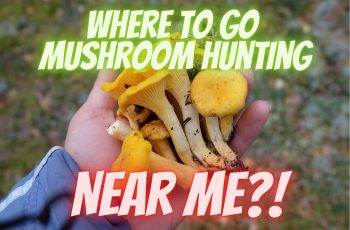Morchella americana is a species of fungus in the Morchellaceae family, commonly known as the Blonde or Yellow Morel. It is a highly prized and sought-after edible mushroom that is widely distributed throughout North America. The fungus has a distinctive appearance, characterized by its spongy pine cone-shaped or egg-shaped head, and a series of mostly vertically oriented dark pits and pale ridges.
Taxonomy and Description:
Morchella americana was first described as new to science in 2012 and is closely related to other species of the Morchella genus. The true morels, as they are commonly known, are a genus of edible sac fungi that have a honeycomb appearance due to the network of ridges with pits composing their caps. The distinctive features of M. americana make it easy to identify, making it a popular choice for mushroom hunters and enthusiasts.
Habitat and Distribution:
Morchella americana is commonly found east of the Rocky Mountains in a range stretching from Ontario south to Texas, Arkansas, Alabama, Georgia, and South Carolina. The fungus thrives in a variety of habitats, including deciduous and coniferous forests, orchards, and disturbed areas. M. americana is also known to form associations with certain tree species, including ash, elm, and tulip poplar.
Key Takeaways
- Morchella americana is a highly prized and sought-after edible mushroom that is widely distributed throughout North America.
- M. americana has a distinctive appearance, characterized by its spongy pine cone-shaped or egg-shaped head, and a series of mostly vertically oriented dark pits and pale ridges.
- The fungus thrives in a variety of habitats, including deciduous and coniferous forests, orchards, and disturbed areas, and is known to form associations with certain tree species.
Taxonomy and Description
Morchella americana is a species of fungus in the Morchellaceae family and belongs to the Morchella/Esculenta Clade of yellow morels. It was first described as new to science in 2012 by Clowez and Matherly. The species is native to North America and is commonly found east of the Rocky Mountains in a range stretching from Ontario south to Texas, Arkansas, Alabama, Georgia, and South Carolina. In western North America, the species is typically found under hardwood trees in river bottoms or with apple trees or ornamental ashes.
Morchella americana is one of six common morels discussed in the Wild-foraged Mushroom Certification Program. The other five are Morchella angusticeps, Morchella diminutiva, Morchella exuberans, Morchella importuna, and Morchella punctipes. The species can be identified by its distinctive blonde or pale yellow cap with deep pits and ridges, which resembles a honeycomb. The cap is attached to a hollow stem that is white and smooth.
The taxonomy of Morchella americana is as follows:
- Kingdom: Fungi
- Phylum: Ascomycota
- Class: Pezizomycetes
- Order: Pezizales
- Family: Morchellaceae
- Genus: Morchella
- Species: Morchella americana
Morchella americana is closely related to other yellow morels, including Morchella esculentoides, Morchella ulmaria, Morchella angusticeps, Morchella diminutiva, Morchella exuberans, Morchella punctipes, and Morchella cryptica. However, each species can be distinguished by subtle differences in morphology, such as cap color, shape, and size, as well as microscopical features.
Related Posts:
- Grey Mushrooms: A Guide to Identifying and Cooking Them
- Tree Mushrooms: A Comprehensive Guide to Identification and Uses
Habitat and Distribution
Morchella americana is a fungus species that is native to North America. It is commonly found in the Great Lakes region, stretching from Ontario to Texas, Arkansas, Alabama, Georgia, and South Carolina. The species is also found in the Rocky Mountains and western North America. In western North America, it is typically found under hardwood trees in river bottoms or with apple trees or ornamental ashes in urban areas.
Morchella americana is a saprophytic fungus that grows in a variety of habitats, including disturbed areas, gardens, and parks. It prefers well-drained soil and is often found in areas with ample moisture and sunlight. The species is also known to grow in disturbed areas, such as along roadsides and in abandoned fields.
In addition to North America, Morchella americana has also been found in other parts of the world, including Canada, Turkey, France, and Germany.
Related Posts:
- Where to Go Mushroom Hunting Near Me: A Friendly Guide
- Mushroom Hunting in Oklahoma: Tips, Regulations, and Best Spots
- Mushroom Hunting in Indiana: Tips, Tricks, and Best Spots
- Wild Mushrooms in Ohio: A Guide to Identifying and Safely Foraging for Local Varieties
- Finding Morel Mushrooms in Virginia: Tips and Tricks for Successful Hunting
Cultivation and Edibility
Morchella americana, commonly known as the Blonde or Yellow Morel, is a prized edible mushroom found in North America. While it is primarily found in the wild, attempts have been made to cultivate it with some degree of success.
Cultivation of Morchella americana requires carefully prepared soil with plenty of decaying wood matter in it, as well as the proper amount of shade and moisture. The process involves creating a bed of soil mixed with wood chips and spores, and then keeping the bed moist and shaded. The fruiting season for Morchella americana is typically in the spring, but can vary depending on the climate.
When it comes to edibility, Morchella americana is highly sought after for its unique flavor and texture. It is often breaded and fried, or used in a variety of dishes such as omelettes and soups. However, it is important to note that some people may have allergic reactions to Morchella mushrooms, so caution should be exercised when trying them for the first time.
Overall, Morchella americana is a delicious and prized mushroom that can be cultivated with some effort and care. Its unique flavor and texture make it a favorite among mushroom hunters and chefs alike.
Related Posts:
- Edible Mushrooms in Ohio – Primer!
- How to Store Morel Mushrooms: Tips and Tricks
- Edible Mushrooms in PA: A Comprehensive Guide to Safe Foraging
- Edible Mushrooms in Oklahoma: A Guide to Finding and Identifying Safe Varieties
- How Fast Do Morels Grow? A Comprehensive Guide to Morel Growth Rates
Interactions with Other Organisms
Morchella americana, like other morel species, interacts with various organisms in its habitats. They are saprotrophic fungi that decompose organic matter, such as dead plant material, and recycle nutrients back into the ecosystem. Morchella species are also known to form mutualistic relationships with trees, particularly hardwoods like elm and ash, as well as conifers and cottonwood trees. The fungi exchange nutrients and water with the trees in exchange for carbohydrates.
In addition to their symbiotic relationships with trees, Morchella species also interact with other fungi. Some species of morels, such as the yellow morel and the half-free morel, have been found to coexist with endophytic fungi, which live within the tissues of plants without causing any harm. These endophytes may provide benefits to the morels, such as protection from herbivores or increased tolerance to environmental stressors.
Morchella species are also important food sources for animals, including insects, birds, and mammals. Some species of morels, such as the black morel and the gray morel, are known to be toxic to humans if not cooked properly, but they are still consumed by some animals without any ill effects.
Overall, Morchella americana and other morel species play important roles in their ecosystems, interacting with a variety of organisms to maintain the balance of nutrients and energy flow.
Related Posts:
- Morel Spores: A Comprehensive Guide to Cultivation and Harvesting
- Morel Mushrooms Spores: A Comprehensive Guide to Cultivation
References and Further Reading
For those interested in learning more about Morchella americana, there are a variety of resources available. The following references provide information on the identification, distribution, and ecology of this species.
- Bueg, M., Bessette, A, Bessette, Arlene. 2014. Ascomycete Fungi of North America: a mushroom reference guide. This comprehensive guide provides detailed information on the identification and ecology of Morchella species, including M. americana.
- Clowez, P., & Matherly, R. E. (2012). Morchella americana sp. nov. and Morchella populiphila sp. nov.: two new morel species from the United States. Mycologia, 104(5), 1170-1180. This scientific article describes the discovery and taxonomy of M. americana, including its distinguishing morphological features and genetic characteristics.
- Miller, A. N., Miller, O. K., & Miller, L. L. (2017). Mushrooms of the Midwest. University of Illinois Press. This field guide provides a comprehensive overview of the fungi found in the Midwest region of the United States, including M. americana.
- O’Donnell, K., & Cigelnik, E. (1997). Two divergent intragenomic rDNA ITS2 types within a monophyletic lineage of the fungus Fusarium are nonorthologous. Molecular phylogenetics and evolution, 7(1), 103-116. This scientific article provides information on the molecular phylogenetics of Morchella species, including M. americana.
- United States Department of Agriculture. (n.d.). Morchella americana Clowez & Matherly. Retrieved from https://www.fs.fed.us/nrs/mushrooms/morchella_americana.html. This webpage provides information on the distribution and ecology of M. americana, as well as tips on identification and harvesting.
Overall, these resources provide a wealth of information on Morchella americana, from its taxonomy and morphology to its distribution and ecology. Whether you are a mycological researcher or simply a curious mushroom enthusiast, these references offer valuable insights into this fascinating species.
Frequently Asked Questions
What are the different species of morel mushrooms?
There are several species of morel mushrooms, including Morchella esculenta, Morchella conica, Morchella elata, and Morchella angusticeps. Morchella americana is another species of morel that is commonly found in North America.
What are some mushrooms that look similar to Morchella americana?
Some mushrooms that may be mistaken for Morchella americana include false morels (Gyromitra esculenta and Verpa bohemica), which are toxic and should not be consumed. Other mushrooms that resemble Morchella americana include the half-free morel (Morchella semilibera) and the black morel (Morchella elata).
Why are morel mushrooms so expensive?
Morel mushrooms are expensive due to their unique flavor and texture, as well as their limited availability. Morels are difficult to cultivate and are primarily found in the wild, making them a rare and sought-after delicacy.
Can Morchella americana be eaten raw?
Morchella americana should not be eaten raw as it may contain harmful toxins. It is recommended to cook morel mushrooms thoroughly before consuming.
Are black morels safe to eat?
Black morels (Morchella elata) are safe to eat when cooked properly. However, it is important to distinguish them from false morels (Gyromitra esculenta and Verpa bohemica), which are toxic and should not be consumed.
What distinguishes Morchella americana from black morels?
Morchella americana is typically smaller and lighter in color than black morels. It has a sponge-like head that is egg-shaped, oval to conical, or pine cone-shaped with pits and ridges that are primarily vertically arranged. Black morels, on the other hand, have a dark, honeycomb-like head with pits and ridges that are primarily horizontally arranged.


